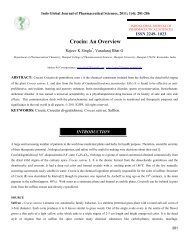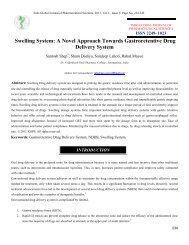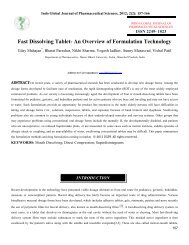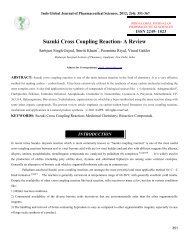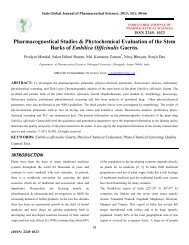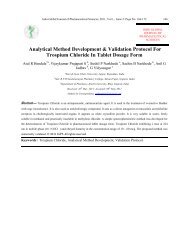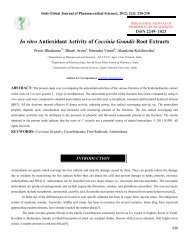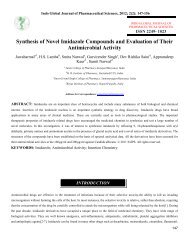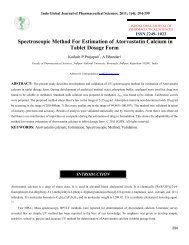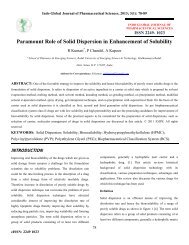Therapeutic Potentials of Bambusa bambos Druce - Indo Global ...
Therapeutic Potentials of Bambusa bambos Druce - Indo Global ...
Therapeutic Potentials of Bambusa bambos Druce - Indo Global ...
You also want an ePaper? Increase the reach of your titles
YUMPU automatically turns print PDFs into web optimized ePapers that Google loves.
<strong>Indo</strong> <strong>Global</strong> Journal <strong>of</strong> Pharmaceutical Sciences, 2012; 2(1): 85-87<br />
<strong>of</strong> this plant has been reported to be used as a cure for eruption. The stem and leaves are also used as blood purifier. Roots are used to<br />
cure for eruption. Stem and leaves are used as blood purifier. The shoot deposited on culms mixed with lime or even with fine<br />
powdered coke is applied to cuts and wounds [3] .<br />
THERAPEUTIC USES<br />
Fresh juice <strong>of</strong> the leaves <strong>of</strong> <strong>Bambusa</strong> <strong>bambos</strong> was tested for uterine activity on isolated human as well as rat uterus and it was<br />
found to have a weak ecbolic action (an agent produces rapid labour) in a dose 1 to 10 mg/ml. Extract <strong>of</strong> its leaves show<br />
antitumor activity in rat. Extract <strong>of</strong> its leaves show antitumor activity in rat. Extract <strong>of</strong> its leaves show antitumor activity in rat. Hot<br />
water extract and alcoholic extract <strong>of</strong> the leaves <strong>of</strong> this plant was used as deodorant. An ethanolic extract <strong>of</strong><br />
<strong>Bambusa</strong> <strong>bambos</strong> tender shoot caused a reduction in fertility <strong>of</strong> male rat. The dealcoholized extract <strong>of</strong> leaves has shown<br />
antibacterial activity against Bacillus subtillis, Micrococcus pyogens, Staphylococcus aureus and Salmonella typhi at a<br />
concentration <strong>of</strong> 0.1-0.35% (at pH 7 and pH 5.5) . Hot water extract and alcoholic extract <strong>of</strong> leaves used as<br />
deodorant. The dealcoholised extract <strong>of</strong> leaves has shown antibacterial activity . Leaves <strong>of</strong> <strong>Bambusa</strong> <strong>bambos</strong> contain digestible<br />
crude amino acid, mainely methionine and lysine [3]. Literature review reveals that studieson food safety aspect <strong>of</strong> bamboo shoot are<br />
unsystematic and scanty, hence need special attention. Similarly indepth investigation on effect <strong>of</strong> processing (boiling, fermenting,<br />
canning etc.) on total nutrient content (macro and micro) <strong>of</strong> various bamboo shoot species growing in different agroecological<br />
regions needs to be carried out. It would help in converting the non-edible species into edible one, thus enhancing the<br />
business scope for rural people. Scientific validation <strong>of</strong> indigenous knowledge <strong>of</strong> tribal coupled with modern scientific inputs<br />
would provide guidelines for evolving a simple, efficient system for bamboo shoot utilization. Thus, several important<br />
knowledge gaps identified in this paper would give impetus to new academic and R&D activities, in turn generating innovative job<br />
pr<strong>of</strong>ile in food industries as well as rural entrepreneurship [4].<br />
CONCLUSION<br />
The plant <strong>Bambusa</strong> <strong>bambos</strong> is one <strong>of</strong> the most important sources <strong>of</strong> medicine phytochemicals widely experimented by<br />
scientist. The initiation to such a huge number <strong>of</strong> investigation on this plant come from Ethnopharmacology where a number <strong>of</strong><br />
uses <strong>of</strong> all the parts <strong>of</strong> this plant have been sited. Present study enlisted the pharmacological properties <strong>of</strong> the plant like <strong>Bambusa</strong><br />
<strong>bambos</strong>. The investigated pharmacological uses may be due to the presence <strong>of</strong> the phytoconstituents. Furthermore in future detailed<br />
phytopharmacological studies are to be done on this highly propagation plant. The pharmacological studies will be exploited for the<br />
responsible mechanism and phytoconstituents.<br />
REFERENCES<br />
1. P.Shanmughavel, R.S. Peddappaiah, J.M. Kumar, Biomass production in age series <strong>of</strong> bambusa <strong>bambos</strong> plantation, Biomass and<br />
Bioenergy, 20(2), 2001, 113–117.<br />
2. S.S.R. Bennet, R. C. Gaur, Thirty seven <strong>bambos</strong> growing in India, Forest Research Institute, Dehra Dun Forest Research Institute, Dehra<br />
Dun, 19, 1990, 21<br />
3. M.Kundu, S.Das, S.Kumari,S.P.Basu, Study on aqueous leaf extract <strong>of</strong> bambusa <strong>bambos</strong> “<strong>Druce</strong>” as a potent hypothermic agent, IJPI’S<br />
Journal <strong>of</strong> pharmacology and Toxicology, 1(6), 2011, 55-60.<br />
4. S. Satya, L.M. Bal, P. Singhal, S.N. Naik, Bamboo shoot processing: food quality and safety aspect (a review), Trend in food science and<br />
technology, 2010, 21(4) 181-189.<br />
87





